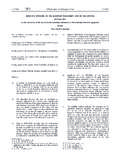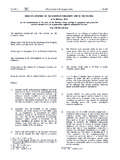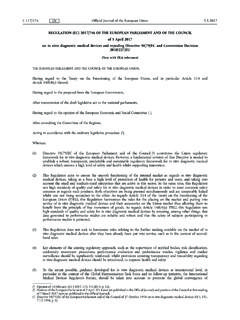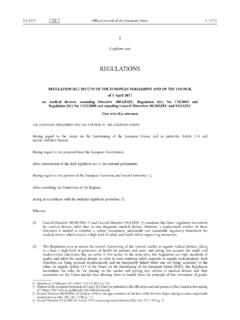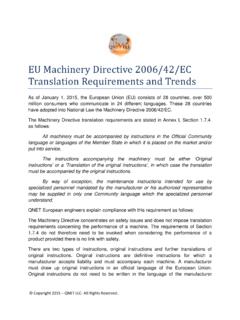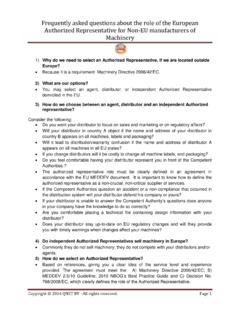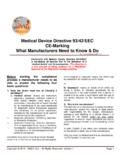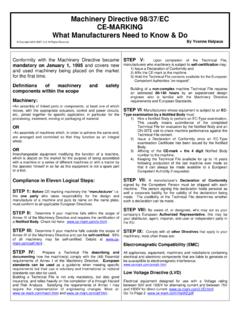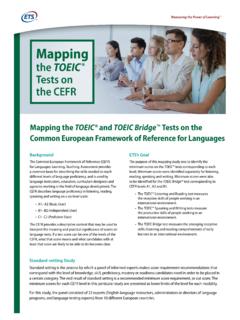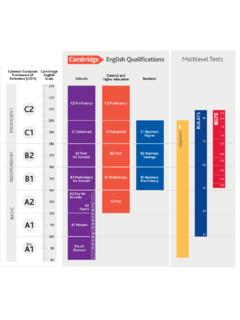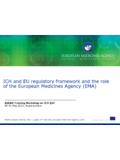Transcription of DECISIONS ADOPTED JOINTLY BY THE EUROPEAN …
1 DECISIONS ADOPTED JOINTLY BY THE EUROPEAN parliament AND THECOUNCILDECISION No 768/2008/EC OF THE EUROPEAN parliament AND OF THE COUNCILof 9 July 2008on a common framework for the marketing of products, and repealing council Decision 93/465/EEC(Text with EEA relevance)THE EUROPEAN parliament AND THE council OF THEEUROPEAN UNION,Having regard to the Treaty establishing the EUROPEAN Commu-nity, and in particular Article 95 thereof,Having regard to the proposal from the Commission,Having regard to the opinion of the EUROPEAN Economic andSocial Committee (1),After consulting the Committee of the Regions,Acting in accordance with the procedure laid down in Article 251of the Treaty (2),Whereas:(1)On 7 May 2003 the Commission issued a Communicationto the council and the EUROPEAN parliament entitled Enhancing the Implementation of the New ApproachDirectives . In its Resolution of 10 November 2003 (3), theCouncil acknowledged the importance of the NewApproach as an appropriate and efficient regulatory modelallowing technological innovation and enhancing thecompetitiveness of EUROPEAN industry, and confirmed thenecessity of extending the application of its principles tonew areas, while recognising the need for a clearerframework for conformity assessment, accreditation andmarket surveillance.
2 (2)This Decision lays down common principles and referenceprovisions intended to apply across sectoral legislation inorder to provide a coherent basis for revision or recasts ofthat legislation. This Decision therefore constitutes ageneral framework of a horizontal nature for futurelegislation harmonising the conditions for the marketingof products and a reference text for existing legislation.(3)This Decision provides, in the form of reference provisions,definitions and general obligations for economic operatorsand a range of conformity assessment procedures fromwhich the legislator can select as appropriate. It also laysdown rules for CE marking. Furthermore, referenceprovisions are provided as regards the requirements forconformity assessment bodies to be notified to theCommission as competent to carry out the relevantconformity assessment procedures and as regards thenotification procedures.
3 In addition, this Decision includesreference provisions concerning procedures for dealingwith products presenting a risk in order to ensure the safetyof the market place.(4)Whenever legislation is drawn up which concerns a productalready subject to other Community acts, those acts mustbe taken into account to ensure the consistency of alllegislation concerning the same product.(5)However, the specificities of sectoral needs may providegrounds for recourse to other regulatory solutions. Inparticular, that is the case where there are specific,comprehensive legal systems already in place in a sector,as for example in the fields of feed and food, cosmetic andtobacco products, common market organisations foragricultural products, plant health and plant protection,human blood and tissues, medicinal products for humanand veterinary use and chemicals, or where sectoral needsrequire specific adaptation of the common principles andreference provisions, as for example in the fields of medicaldevices, construction products and marine equipment.
4 Suchadaptations may also be related to the modules set out inAnnex 218/82 ENOfficial Journal of the EUROPEAN (1) OJ C 120, , p. 1.(2) Opinion of the EUROPEAN parliament of 21 February 2008 (not yetpublished in the Official Journal) and council Decision of 23 June2008.(3) OJ C 282, , p. 3.(6)Whenever legislation is drawn up, the legislator may depart,totally or partially, from the common principles andreference provisions laid down in this Decision on accountof the specificities of the sector concerned. Any suchdeparture should be justified.(7)Although the incorporation of the provisions of thisDecision in future legislative acts cannot be required by law,the co-legislators adopting this Decision have entered into aclear political commitment which they should respect inany legislative act falling within the scope of this Decision.(8)Specific product legislation should, wherever possible,avoid going into technical detail but should limit itself tothe expression of essential requirements.
5 Such legislationshould, where appropriate, have recourse to harmonisedstandards ADOPTED in accordance with Directive 98/34/ECof the EUROPEAN parliament and of the council of 22 June1998 laying down a procedure for the provision ofinformation in the field of technical standards andregulations and of rules on Information Society servi-ces (1) for the purpose of expressing detailed technicalspecifications. This Decision builds on and complementsthe standardisation system provided for by that , where health and safety, the protection ofconsumers or of the environment, other aspects of publicinterest, or clarity and practicability so require, detailedtechnical specifications may be set out in the legislationconcerned.(9)The presumption of conformity to a legal provisionconferred by conformity to a harmonised standard shouldenhance recourse to compliance with harmonised stan-dards.(10)It should be possible for Member States or the Commissionto object in cases in which a harmonised standard does notentirely satisfy the requirements of Community harmonisa-tion legislation.
6 The Commission should be able to decidenot to publish such a standard. To that end, theCommission should, in such manner as appropriate,consult sectoral representatives and Member States beforethe Committee set up by Article 5 of Directive 98/34/ECdelivers its opinion.(11)The essential requirements should be worded preciselyenough to create legally binding obligations. They shouldbe formulated so as to make it possible to assess conformitywith them even in the absence of harmonised standards orwhere the manufacturer chooses not to apply a harmonisedstandard. The degree of detail of the wording will dependon the characteristics of each sector.(12)The successful accomplishment of the required conformityassessment procedure enables economic operators todemonstrate and the competent authorities to ensure thatproducts made available on the market conform to therequirements applicable.
7 (13)The modules for the conformity assessment procedures tobe used in the Community harmonisation legislation wereinitially set out in council Decision 93/465/EEC of 22 July1993 concerning the modules for the various phases of theconformity assessment procedures and the rules for theaffixing and use of the CE conformity marking, which areintended to be used in the technical harmonisationdirectives (2). This Decision replaces that Decision.(14)It is necessary to offer a choice of clear, transparent andcoherent conformity assessment procedures, restricting thepossible variants. This Decision provides for a menu ofmodules, enabling the legislator to choose a procedurefrom the least to the most stringent, in proportion to thelevel of risk involved and the level of safety required.(15)For the purposes of ensuring inter-sectoral coherence andavoiding ad-hoc variants, it is desirable that the procedureswhich are to be used in sectoral legislation be chosen fromamong the modules, in accordance with the general criteriaset out.
8 (16)In the past, legislation on the free movement of goods hasused a set of terms partly without defining them andguidelines for explanation and interpretation have conse-quently been necessary. Where legal definitions have beenintroduced they differ to some extent in their wording andsometimes in their meaning, which gives rise to difficultiesin their interpretation and correct implementation. ThisDecision therefore introduces clear definitions of certainfundamental concepts.(17)Products that are placed on the Community market shouldcomply with the relevant applicable Community legislation,and economic operators should be responsible for thecompliance of products, in relation to their respective rolesin the supply chain, so as to ensure a high level ofprotection of public interests, such as health and safety, andthe protection of consumers and of the environment, andto guarantee fair competition on the Community market.
9 (18)All economic operators are expected to act responsibly andin full accordance with the legal requirements applicablewhen placing or making products available on the market.(19)All economic operators intervening in the supply anddistribution chain should take appropriate measures toensure that they make available on the market onlyproducts which are in conformity with the applicablelegislation. This Decision provides a clear and propor-tionate distribution of obligations which correspond to therole of each operator in the supply and distribution Journal of the EUROPEAN UnionL 218/83(1) OJ L 204, , p. 37. Directive as last amended by CouncilDirective 2006/96/EC (OJ L 363, , p. 81).(2) OJ L 220, , p. 23.(20)As certain tasks can be executed only by the manufacturer,it is necessary to distinguish clearly between the manu-facturer and operators further down the distribution is also necessary to distinguish clearly between theimporter and the distributor, as the importer introducesproducts from third countries to the Community importer has thus to make sure that those productscomply with the applicable Community requirements.
10 (21)The manufacturer, having detailed knowledge of the designand production process, is best placed to carry out thecomplete conformity assessment procedure. Conformityassessment should therefore remain the obligation of themanufacturer alone.(22)It is necessary to ensure that products from third countriesentering the Community market comply with all applicableCommunity requirements, and in particular that appro-priate assessment procedures have been carried out bymanufacturers with regard to those products. Provisionshould therefore be made for importers to make sure thatthe products they place on the market comply with theapplicable requirements and that they do not place on themarket products which do not comply with suchrequirements or present a risk. For the same reason,provision should also be made for importers to make surethat conformity assessment procedures have been carriedout and that product marking and documentation drawnup by manufacturers are available for inspection by thesupervisory authorities.
